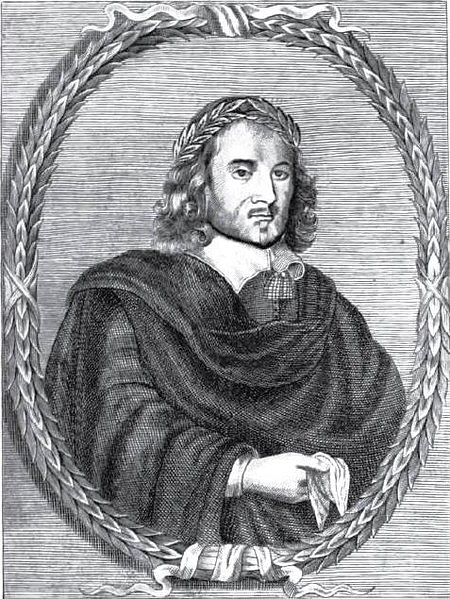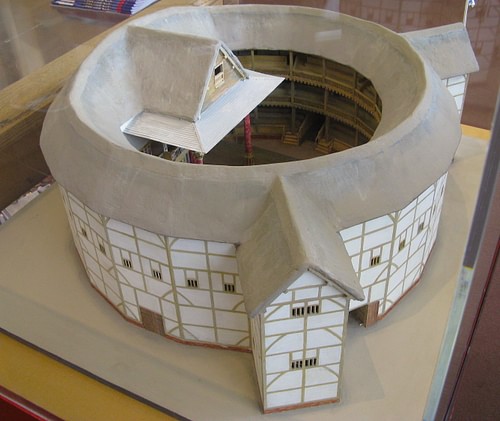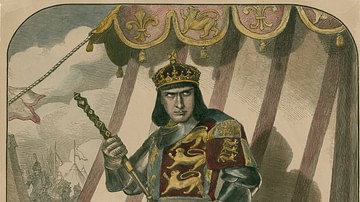
Thomas Middleton (1580-1627) was a poet and playwright of the English Renaissance, who flourished during the Jacobean Era (1603-1625). One of the most successful dramatists of his time, he often collaborated with other playwrights, including John Webster, Thomas Dekker, and most notably, William Shakespeare (1564-1616) – indeed, Middleton is thought to have co-wrote Timon of Athens (circa 1606) with Shakespeare and provided revisions for Macbeth and Measure for Measure. Middleton was a prolific writer, who penned masques, pageants, and plays, excelling in both genres of tragedy and comedy. His best-known works include The Revenger's Tragedy (1606), The Changeling (1622), and A Game at Chess (1624).
Early Life
Thomas Middleton was born in London in the spring of 1580 and was baptized on 18 April. His father, a bricklayer, died when he was only six years old, leaving behind an estate valued at £335, a substantial amount. His mother, Anne, soon took a second husband, a gentleman grocer named Thomas Harvey. Harvey had invested in Sir Walter Raleigh's ill-fated Roanoke Colony, which was mysteriously abandoned by its colonists in 1587. Having lost a lot of money in the venture, Harvey was unable to pay back his debts and spent much of his marriage either hiding from creditors or serving stints in debtor's jail. In his desperation, Harvey eventually tried to access the inheritance left behind by Middleton's late father, which Anne had placed in a trust for her two children. This initiated a frustrating, 15-year legal battle that played out over the course of Middleton's childhood. This experience likely led to his later satirical critiques of lawyers and the legal system.
In 1598, Middleton left the family drama behind to attend Queen's College, Oxford, though he only studied there for a few years before dropping out, without having obtained a degree. Around this time, Middleton made his first attempt at writing poetry – his work The Wisdom of Solomon Paraphrased was an ambitious first project, coming in at 4,166 lines, which, as scholar Stanley Wells points out, is longer than the longest text of Hamlet. The poem was dedicated to the Earl of Essex, likely in an effort to secure his patronage, though it is unlikely that Essex ever read it; indeed, the poem was unsuccessful and was hardly read at all. Undaunted, Middleton tried again with the much shorter (only 539 lines) poem, The Ghost of Lucrece (1600). This poem was inspired, both narratively and stylistically, by William Shakespeare, whose own poem, The Rape of Lucrece, had been published several years earlier to great acclaim. Middleton meant for his poem to be a kind of sequel to Shakespeare's, using much of the same imagery and composing it in the same rhyme scheme.
It is clear that, by the time he started writing poetry, Middleton had become fascinated with Elizabethan theatre and had already begun to idolize some of its major figures like Shakespeare. In February 1601, a witness in one of the family's lawsuits testified that Middleton was "in London daily accompanying the players," which confirms that he was at least going to the theatre every day, if not already working as an apprentice writer (quoted in Wells, 169). A few months later, he inherited £25, which was all that was left to him from his father's estate after the exhaustive legal battle. With a pressing need for money, Middleton turned to writing satirical pamphlets. These did well enough to earn him the attention of Philip Henslowe, the leading impresario of public theatre in London, who was soon commissioning him to write plays.
Career Beginnings
Middleton began his career as a playwright in May 1602, when he collaborated with four other writers – Michael Drayton, Thomas Dekker, Anthony Munday, and John Webster – on a (now lost) play entitled Caesar's Fall, or Two Shapes. Henslowe had paid the five writers £8 for the play, which was probably intended to help his acting company, the Lord Admiral's Men, compete with their rival troupe, the Lord Chamberlain's Men, who were performing Shakespeare's Julius Caesar with great success. Middleton and Webster had both worked on this play as 'novices', subordinate to the more experienced playwrights. But within only a few months, Middleton was already working on plays by himself, earning £7 for The Chester Tragedy (also now lost). In December 1602, he was commissioned to write a prologue and an epilogue for a court performance of Robert Greene's play Friar Bacon and Friar Bongay. And so, less than a year after collaborating on his first project, Middleton was already well on his way to making a name for himself. Scholar Stanley Wells describes his career progression:
Immensely industrious, versatile, a brilliant writer whose work developed in power and profundity as his experience grew, Middleton led a quiet life in comparison with, for instance, [Christoper] Marlowe and [Ben] Jonson – though his career was to end in a blaze of publicity. (169)
In 1603, Middleton married Magdalen Marbeck (1575-1628), who may have been introduced to him by her brother Thomas, an actor with the Lord Admiral's Men. That same year, an outbreak of plague forced the theatres of London to close, and Middleton turned to writing prose pamphlets. When the theatres reopened, Middleton began one of the most productive periods of his career, writing "a brilliant series of comedies centered, whether explicitly or not, on London life of the day" (Wells, 171). The first of these comedies was The Phoenix (1603), acted by a company of boy actors and performed for King James I of England (r. 1603-1625) during his first court season in February 1604. The play, set in the Italian dukedom of Ferrara, follows Phoenix, the son of a duke who disguises himself so that he can "look into the heart and bowels of this dukedom" and "mark all abuses ready for reformation or punishment" (1.1.100-102). This motif, of a ruler disguising himself to observe the abuses and corruption in his realm, was common in early Jacobean plays and can also be found in Shakespeare's Measure for Measure. Middleton cannot help mocking lawyers, in the form of his pedantic lawyer character Tangle, nor can he help satirizing the issues of contemporary England, specifically the king's unpopular practice of indiscriminately selling knighthoods to fill the royal coffers.
The king must not have noticed this subtle jab, for Middleton was soon selected to write a speech for the Magnificent Entertainment Given to King James, which marked the king's official entry into London – this was a big step for Middleton's career, as he was now writing for the same events as established writers like Ben Jonson and Thomas Dekker. Indeed, Middleton soon struck up a working relationship with Dekker; in February 1604, they received an advance of £5 from Henslowe to write The Honest Whore, Part One, which proved to be a massive success. Middleton also wrote several successful comedies on his own, including Michaelmas Term (1604), A Mad World, My Masters (1605), A Trick to Catch the Old One (1605), and The Puritan Widow (1606). In 1605, he (very likely) wrote The Yorkshire Tragedy, a one-act play based on the real-life story of Walter Calverley, a young Yorkshire man who murdered his two children and wounded his wife before he was arrested and, ultimately, executed by being pressed to death. As was common with Middleton's work, none of the characters have personal names and are referred to only as 'Husband' or 'Son'. The Husband, believing his sons to be "Bastards begot in tricks" resolves to kill them, leading to this harrowing scene:
HUSBAND: (striking him) Thou shalt be my red boy. Take that!
SON: O, you hurt me, father!
HUSBAND: My eldest beggar. Thou shalt not live to ask an usurer bread, to cry at a great man's gate, or follow 'good your honour' by a crouch, no, nor your brother. 'Tis a charity to brain you.
SON: How shall I learn now my head's broke?
HUSBAND: Bleed, bleed rather than beg, beg.
(quoted in Wells, 177)
This short, ten-scene play ends without resolving the Husband's fate, which would have unnerved Jacobean audiences, who were used to seeing moralistic resolutions in their plays. The Yorkshire Tragedy was an excellent piece of tragedy, made even more extraordinary by the fact that its author had previously only been known for his comedies. As Wells puts it, "Nothing in Middleton's output up to this date would have prepared one for the possibility that he could have written so powerful a tragedy at this stage in his career" (176). Clearly, Middleton was well on his way to mastering both the comedy and the tragedy, and becoming one of the best dramatists of his era.
Collaborations with Shakespeare
When The Yorkshire Tragedy was first published, it was initially attributed to Shakespeare – whether this was done by the publisher in the hopes of selling more copies or for some other reason cannot be known. But the play was apparently performed by the King's Men (formerly the Lord Chamberlain's Men, the acting company with whom Shakespeare wrote), which may have been how Middleton was first introduced to the man who had inspired him to write his first poems all those years ago. The idea that Middleton co-wrote Shakespeare's Timon of Athens is not undisputed amongst Shakespearean scholars; Harold Bloom, for instance, says that the evidence is "not at all persuasive" (588). Nevertheless, the prevailing idea today is that Middleton did indeed have some hand in writing the play, though the nature of the collaboration continues to be debated.

The notion that Shakespeare did not write Timon of Athens by himself is supported by several factors; for instance, there are multiple narrative inconsistencies (a mistake uncharacteristic of Shakespeare) as well as different writing styles used in different places. Indeed, the quality of the play differs from Shakespeare's other tragedies in its use of satire and in its high proportion of characters who lack personal names – characters are referred to as the Poet, the Painter, and the Merchant, which, as has been noted, was typical of Middleton's work. Much of the verse is more similar to Middleton's work than Shakespeare's, and linguistic study has shown that many of the words, phrases, and punctuation used in the play are common to Middleton but rare to Shakespeare. If Middleton did collaborate, as it seems likely he did, the question remains whether he worked on it with Shakespeare or merely worked on a revised edition later. There is also evidence that Middleton added revisions to Macbeth and Measure for Measure, and it has even been suggested that he collaborated with Shakespeare again on All's Well That Ends Well. However, these ideas are much more contested and are not universally accepted by scholars.
Later Career & Legacy
In 1606, Middleton continued to focus on writing tragedy, this time penning a revenge play entitled The Revenger's Tragedy. Revenge tragedies – in which a wronged protagonist plots, and ultimately takes, vengeance against his enemies – had been quite popular in the 1580s, and were revitalized by the success of Shakespeare's Hamlet (circa 1600). Middleton, in fact, seems to have taken inspiration from Hamlet; The Revenger's Tragedy opens with the protagonist, Vindice, holding the skull of his murdered fiancée. The play, according to Wells, is "a brilliantly funny, primarily ironic, and fundamentally moralistic work" (180) and, characteristically of Middleton, the characters' names are all allegorical; Vindice, for example, means 'revenger'. The play ends with Vindice achieving his vengeance by tricking the Duke, who has killed his fiancée, into kissing her poisoned skull. The Revenger's Tragedy proved popular and was likely performed by the King's Men at the Globe Theatre in 1607.
By this point, Middleton, though not yet 30, had enjoyed quite a productive career. But he was forced to slow down between 1608 and 1610 as his debts finally caught up to him; he was arrested for debt in December 1608 and sued by a creditor the following year. Before long, he was back to work, co-writing two plays with Thomas Dekker – The Bloody Banquet (1609) and The Roaring Girl (1611) – and independently wrote No Wit, No Help Like a Woman's and The Second Maiden's Tragedy (both 1611). By the mid-1610s, he had turned to writing tragicomedies, including The Witch (1616) – this play, first performed by the King's Men, seems to have caused a scandal that led the authorities to block its publication. It is around this time that Middleton seems to have become more closely involved with the King's Men (Shakespeare had died in April 1616), revising works in their repertoire to be more relevant to the times. Also around this time, he became more involved in writing pageants for the city of London, and he was officially appointed as the city's chronologist in 1620.
It was toward the end of his career that Middleton wrote some of his most famous works. The Changeling (1622), written in collaboration with William Rowley, is often regarded as one of the best tragicomedies of the English Renaissance. In the tragic main plot, a woman, Beatrice-Joanna, plans the murder of her fiancé so she can be with her lover, manipulating a servant who also secretly loves her into doing the deed. The comic subplot follows a married couple who are visited by two suitors who pretend to be a madman and a fool, respectively, in order to get closer to the wife. The play deals with themes of treachery and original sin. Another of Middleton's masterpieces is his final, controversial play, A Game at Chess (1624). In this play, the characters are represented by chess pieces and are each a stand-in for a contemporary political figure – the villainous Black Knight, for instance, represents the Spanish ambassador Count Gondomar, who is vanquished by the White Knight, a representation of the Prince of Wales (the future Charles I of England).
A Game at Chess was quite popular, with thousands of theatergoers flocking to see one of the nine consecutive performances held at the Globe Theatre in August 1624. But this popularity, undoubtedly driven by the play's controversial subject matter, did not come without cost; as Wells writes, "few plays ever written have caused such a scandal" (192). Count Gondomar, offended at his portrayal, complained to King James I and threatened to leave the country if those responsible for the play were not punished. The play was suppressed, and the actors were summoned before the Privy Council to be reprimanded. Middleton, however, went into hiding – Wells speculates that he may have been caught and imprisoned for a brief time, released on the condition that he not write any more plays. Whatever truly happened, Middleton continued to write pageants for the city of London after this incident, but he never again wrote a play. He died in the summer of 1627 and was buried on 4 July, at the age of 47. Today, he is regarded as one of the most influential dramatists of his time – some critics consider him second only to Shakespeare – and his best-known plays continue to be performed in theatres across the English-speaking world.









